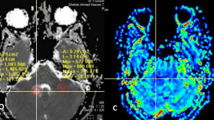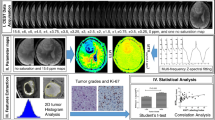Abstract
Objectives
Using MRSI as comparison, we aimed to explore the difference between amide proton transfer (APT) MRI and conventional semi-solid magnetization transfer ratio (MTR) MRI, and to investigate if molecular APT and structural MTR can provide complimentary information in assessing brain tumors.
Methods
Seventeen brain tumor patients and 17 age- and gender-matched volunteers were included and scanned with anatomical MRI, APT and MT-weighted MRI, and MRSI. Multi-voxel choline (Cho) and N-acetylaspartic acid (NAA) signals were quantified from MRSI and compared with MTR and MTRasym(3.5ppm) contrasts averaged from corresponding voxels. Correlations between contrasts were explored voxel-by-voxel by pooling values from all voxels into Pearson’s correlation analysis. Differences in correlation coefficients were tested with the Z-test (set at p<0.05).
Results
APT and MT provide good contrast and quantitative parameters in tumor imaging, as do the metabolite (Cho and NAA) maps. MTRasym(3.5ppm) significantly correlated with MTR (R=-0.61, p<0.0001), Cho (R=0.568, p<0.0001) and NAA (R=-0.619, p<0.0001) in tumors, and MTR also significantly correlated with Cho (R=-0.346, p<0.0001) and NAA (R=0.624, p<0.0001). In healthy volunteers, MTRasym(3.5ppm) was non-significantly correlated with MTR (R=-0.049, p=0.239), Cho (R=0.030, p=0.478) and NAA (R=-0.083, p=0.046). Significant correlations were found among MTR with Cho (R=0.199, p<0.0001) and NAA (R=0.263, p<0.0001) in the group of healthy volunteers with lower correlation R values than those in tumor patients.
Conclusions
APT and MT could provide independent and supplementary information for the comprehensive assessment of molecular and structural changes due to brain tumor cancerogenesis.
Key Points
• MTR asym(3.5ppm) positively correlated with Cho while negatively with NAA in tumors.
• MTR positively correlated with NAA while negatively with Cho in tumors.
• Combining APT/MT provides molecular and structural information similarly to MRSI.




Similar content being viewed by others
Abbreviations
- APT:
-
Amide proton transfer
- MRSI:
-
Magnetic resonance spectroscopy imaging
- MT:
-
Magnetization transfer
- MTR:
-
Conventional magnetization transfer ratio
- MTRasym(3.5ppm) :
-
Asymmetrical magnetization transfer ratio at 3.5 ppm
References
Ramalho J, Ramalho M, AlObaidy M, Semelka RC (2016) Technical aspects of MRI signal change quantification after gadolinium-based contrast agents' administration. Magn Reson Imaging 34(10):1355–1358
Thieme ME, Leeuwenburgh MM, Valdehueza ZD et al (2014) Diagnostic accuracy and patient acceptance of MRI in children with suspected appendicitis. Eur Radiol 24(3):630–637
Deo A, Fogel M, Cowper SE (2007) Nephrogenic systemic fibrosis: a population study examining the relationship of disease development to gadolinium exposure. Clin J Am Soc Nephrol 2(2):264–267
Kuno H, Jara H, Buch K, Qureshi MM, Chapman MN, Sakai O (2017) Global and regional brain assessment with quantitative MR imaging in patients with prior exposure to linear gadolinium-based contrast agents. Radiology 283(1):195–204
Kanda T, Oba H, Toyoda K, Kitajima K, Furui S (2016) Brain gadolinium deposition after administration of gadolinium-based contrast agents. Jpn J Radiol 34(1):3–9
Howe FA, Barton SJ, Cudlip SA et al (2003) Metabolic profiles of human brain tumors using quantitative in vivo 1H magnetic resonance spectroscopy. Magn Reson Med 49(2):223–232
Howe FA, Opstad KS (2003) 1H MR spectroscopy of brain tumours and masses. NMR Biomed 16(3):123–131
Nelson SJ (2003) Multivoxel magnetic resonance spectroscopy of brain tumors. Mol Cancer Ther 2(5):497–507
Okumura A, Takenaka K, Nishimura Y et al (1999) The characterization of human brain tumor using magnetization transfer technique in magnetic resonance imaging. Neurol Res 21(3):250–254
van Buchem MA, Steens SC, Vrooman HA et al (2001) Global estimation of myelination in the developing brain on the basis of magnetization transfer imaging: a preliminary study. AJNR Am J Neuroradiol 22(4):762–766
Zhang H, Kang H, Zhao X et al (2016) Amide Proton Transfer (APT) MR imaging and Magnetization Transfer (MT) MR imaging of pediatric brain development. Eur Radiol 26(10):3368–3376
Kurki T, Lundbom N, Kalimo H, Valtonen S (1995) MR classification of brain gliomas: value of magnetization transfer and conventional imaging. Magn Reson Imaging 13(4):501–511
Zhou J, Lal B, Wilson DA, Laterra J, van Zijl PC (2003) Amide proton transfer (APT) contrast for imaging of brain tumors. Magn Reson Med 50(6):1120–1126
Togao O, Yoshiura T, Keupp J et al (2014) Amide proton transfer imaging of adult diffuse gliomas: correlation with histopathological grades. Neuro Oncol 16(3):441–448
Ma B, Blakeley JO, Hong X et al (2016) Applying amide proton transfer-weighted MRI to distinguish pseudoprogression from true progression in malignant gliomas. J Magn Reson Imaging 44(2):456–462
Park JE, Kim HS, Park KJ, Kim SJ, Kim JH, Smith SA (2016) Pre- and posttreatment glioma: comparison of amide proton transfer imaging with mr spectroscopy for biomarkers of tumor proliferation. Radiology 278(2):514–523
Zhou J, Zhu H, Lim M et al (2013) Three-dimensional amide proton transfer MR imaging of gliomas: Initial experience and comparison with gadolinium enhancement. J Magn Reson Imaging 38(5):1119–1128
Wen Z, Hu S, Huang F et al (2010) MR imaging of high-grade brain tumors using endogenous protein and peptide-based contrast. Neuroimage 51(2):616–622
Brada M (2001) Pathology and genetics of tumours of the nervous system. Br J Cancer 84(1):148
Pui MH (2000) Magnetization transfer analysis of brain tumor, infection, and infarction. J Magn Reson Imaging 12(3):395–399
Kurki T, Lundbom N, Komu M, Kormano M (1996) Tissue characterization of intracranial tumors by magnetization transfer and spin-lattice relaxation parameters in vivo. J Magn Reson Imaging 6(4):573–579
Zheng Y, Wang X, Zhao X (2016) Magnetization transfer and amide proton transfer MRI of neonatal brain development. Biomed Res Int 2016:3052723
Zhou J, Yan K, Zhu H (2012) A simple model for understanding the origin of the amide proton transfer MRI signal in tissue. Appl Magn Reson 42(3):393–402
Gass A, Barker GJ, Kidd D et al (1994) Correlation of magnetization transfer ratio with clinical disability in multiple sclerosis. Ann Neurol 36(1):62–67
Henkelman RM, Stanisz GJ, Graham SJ (2001) Magnetization transfer in MRI: a review. NMR Biomed 14(2):57–64
Ceckler TL, Wolff SD, Yip V, Simon SA, Balaban RS (1992) Dynamic and chemical factors affecting water proton relaxation by macromolecules. J Magn Reson 98(3):637–645
Fralix TA, Ceckler TL, Wolff SD, Simon SA, Balaban RS (1991) Lipid bilayer and water proton magnetization transfer: effect of cholesterol. Magn Reson Med 18(1):214–223
Chen JT, Collins DL, Atkins HL, Freedman MS, Arnold DL, Canadian MS/BMT Study Group (2008) Magnetization transfer ratio evolution with demyelination and remyelination in multiple sclerosis lesions. Ann Neurol 63(2):254–262
Sakata A, Fushimi Y, Okada T et al (2017) Diagnostic performance between contrast enhancement, proton MR spectroscopy, and amide proton transfer imaging in patients with brain tumors. J Magn Reson Imaging 46(3):732–739
Acknowledgements
We thank Bing Wu from GE health for his generous help in data post-processing and advice on the manuscript. We also acknowledge Dr. Yang Fan from General Electric Company (China) for his generous contributions to manuscript revision.
Funding
This study has received funding by grants from the National Program of the Ministry of Science and Technology of China during the “12th Five-Year Plan” (ID: 2011BAI08B10) and the National Natural Science Foundation of China (No. 81171308, No. 81570462, No. 81730049 and No. 81401389). This work is also partially supported by NIH NIBIB grant R21-EB023516-02 (Cai).
Author information
Authors and Affiliations
Corresponding author
Ethics declarations
Guarantor
The scientific guarantor of this publication is Wenzhen Zhu.
Conflict of interest
The authors of this manuscript declare no relationships with any companies whose products or services may be related to the subject matter of the article.
Statistics and biometry
No complex statistical methods were necessary for this paper.
Informed consent
Written informed consent was obtained from all subjects (patients) in this study.
Ethical approval
Institutional Review Board approval was obtained.
Methodology
• Prospective
• Observational
• Performed at one institution
Rights and permissions
About this article
Cite this article
Su, C., Zhao, L., Li, S. et al. Amid proton transfer (APT) and magnetization transfer (MT) MRI contrasts provide complimentary assessment of brain tumors similarly to proton magnetic resonance spectroscopy imaging (MRSI). Eur Radiol 29, 1203–1210 (2019). https://doi.org/10.1007/s00330-018-5615-8
Received:
Revised:
Accepted:
Published:
Issue Date:
DOI: https://doi.org/10.1007/s00330-018-5615-8




